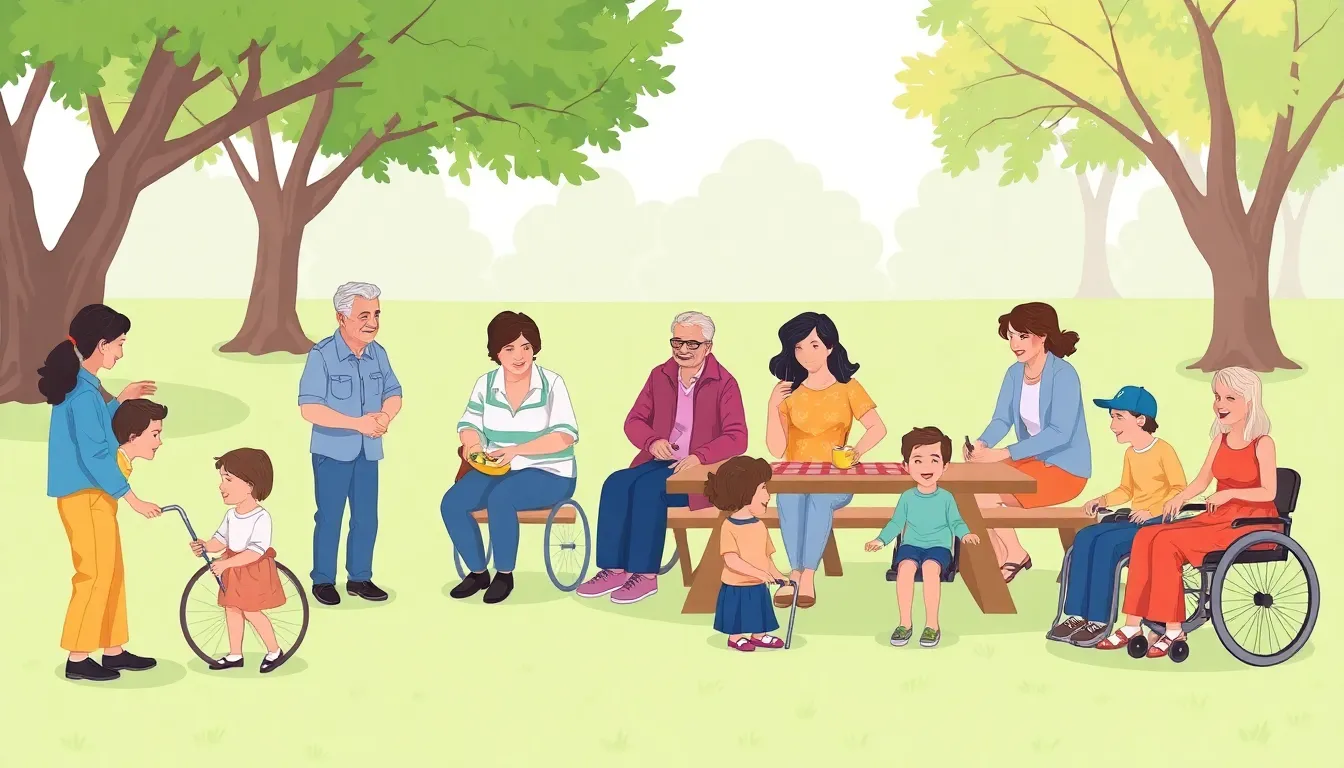Navigating life as a family with disabilities can feel like a rollercoaster ride—thrilling, unpredictable, and sometimes downright hilarious. From the daily hustle of managing schedules to the unique challenges that pop up unexpectedly, these families turn obstacles into opportunities for laughter and connection. They’ve mastered the art of finding joy in the little things, proving that love and resilience can shine even in the toughest moments.
In a world that often overlooks their needs, families with disabilities are not just surviving; they’re thriving. They’re redefining what it means to be a family, showcasing strength and creativity that inspires everyone around them. Join the journey as we explore the vibrant lives of these families, highlighting their stories, struggles, and triumphs, and discovering how they navigate a world that sometimes forgets to include them.
Table of Contents
ToggleUnderstanding Families With Disabilities
Families with disabilities represent a diverse group, facing unique circumstances and experiences. Their dynamics reflect resilience amidst daily life challenges.
Definition and Types of Disabilities
Disabilities encompass various physical, mental, and developmental conditions. Examples include mobility impairments, cognitive disabilities, sensory disabilities, and emotional disorders. Specific conditions such as autism spectrum disorder, Down syndrome, and cerebral palsy frequently affect family structures. Families navigate these categories, adapting to individual needs and strengths. Understanding this classification fosters compassion and awareness of the complexities involved in family life.
Challenges Faced by Families
Daily life presents multiple challenges for families with disabilities. Accessing resources often proves difficult, from transportation to medical care. Emotional stress arises from balancing caregiving with other responsibilities. Financial strain can impact these families significantly, resulting from specialized care costs and reduced employment opportunities. Social isolation occurs when communities lack inclusivity. Managing these hurdles requires immense strength, creativity, and support networks. Families consistently strive to create spaces that promote understanding and acceptance, enhancing their overall well-being.
Support Systems for Families With Disabilities

Support systems play a crucial role in the lives of families with disabilities. Accessing the right resources can significantly enhance their quality of life.
Government Resources and Programs
Numerous government resources exist to aid families with disabilities. The Individuals with Disabilities Education Act (IDEA) provides special education services for children with disabilities, ensuring tailored educational plans. Supplemental Security Income (SSI) offers financial support to families who need assistance with basic living expenses. Medicaid plays a vital role in providing healthcare coverage, allowing families to access necessary medical services. Various state programs target specific needs, offering respite care and independent living services. Utilizing these resources can alleviate some burdens while ensuring families receive adequate support.
Community Support and Organizations
Community organizations offer valuable support to families with disabilities. Local nonprofits often provide programs designed to foster inclusion and social connections, helping families meet others in similar situations. Support groups create spaces for sharing experiences, which can significantly reduce feelings of isolation. Additionally, organizations like the National Down Syndrome Society and Autism Society offer information and advocacy resources tailored to specific disabilities. Engaging with these organizations can empower families through education and social support, enhancing their overall well-being and resilience in the face of difficulties.
Building Awareness and Advocacy
Advocacy and awareness play crucial roles in supporting families with disabilities. Engaging in advocacy amplifies their voices and direct attention to their experiences.
Importance of Advocacy for Families
Advocacy equips families with the tools to navigate challenges. Families benefit from unified efforts that influence policy changes and promote accessible resources. Effective advocacy leads to enhanced services, improved funding for care, and better educational opportunities. Coalition-building among families strengthens their collective impact. An organized approach enables families to share experiences and garner support, fostering a more inclusive environment for all.
Raising Awareness in Society
Raising awareness significantly shifts public perceptions of disabilities. Communities gain insight into the unique challenges families face, leading to greater understanding and support. Education campaigns featuring real-life stories humanize these experiences, encouraging empathy and compassion. Social media offers a platform for families to share their journeys and connect with wider audiences. Increased visibility promotes inclusion, reducing stigma and fostering acceptance within society.
Strategies for Inclusive Environments
Creating inclusive environments significantly enhances the experiences of families with disabilities. Several strategies can promote accessibility and support for these families.
Education and Accessibility
Education plays a critical role in inclusion. Accessible materials, such as braille and audio formats, ensure everyone can participate. Schools must provide individualized education plans to accommodate diverse needs. Training teachers in disability awareness promotes understanding and compassion. Accessible transportation options benefit families by easing commute challenges. Institutions that invest in adaptive technology enhance learning opportunities. Community workshops raise awareness about resources that aid accessibility.
Creating Supportive Home Dynamics
Supportive home dynamics foster resilience and well-being. Open communication establishes trust, allowing family members to express their needs. Flexibility in routines accommodates varying energy levels and health issues. Setting aside quality time together strengthens family bonds. Encouraging independence empowers individuals with disabilities to thrive. Creating a sensory-friendly space can help alleviate stress at home. Collaborating with professional support networks enhances caregiving efforts. These strategies build an environment where all family members feel valued and included.
Families with disabilities embody resilience and creativity in their daily lives. They navigate challenges with strength while fostering connections that enrich their experiences. Through advocacy and community support, these families are not just surviving but thriving, redefining what it means to be a family.
By embracing inclusive practices and raising awareness, society can play a pivotal role in enhancing their quality of life. The stories of these families inspire a deeper understanding of disabilities, encouraging empathy and acceptance. As they continue to advocate for their needs, it’s essential to recognize their contributions and the vibrant lives they lead.



